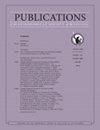用智能手机评估城市灯光对夜空亮度的影响
IF 7.7
3区 物理与天体物理
Q2 ASTRONOMY & ASTROPHYSICS
Publications of the Astronomical Society of the Pacific
Pub Date : 2024-04-02
DOI:10.1088/1538-3873/ad332a
引用次数: 0
摘要
天空的黑暗程度是评估天文观测点是否合适的一个关键参数。在各种光污染源中,城市灯光对地基光学天文和行星观测的威胁最大。定量评估不同尺度和通量的城市灯光的影响,对于选择理想的光学观测点是必不可少的。为了定量评估夜空亮度(NSB)随与城市地区距离的变化,并为青藏高原新开发的冷湖天文观测站的光环境保障奠定基础,我们采用了天空质量测量仪和预先校准的智能手机。我们使用这些仪器测量了青藏高原上大小和辐射通量不同的两个城市--大柴旦和德令哈--附近的 NSB。研究结果表明,随着与市中心距离的增加,两座城市周围的 NSB 都会明显下降,但两地的下降速度有所不同。这种下降可以用指数衰减函数有效地模拟。值得注意的是,当距离 Da Qaidam 超过 30 千米时,城市灯光对 NSB 的影响就可以忽略不计了,而对于德令哈来说,由于其城市规模较大,总辐射通量较高,这一距离可延伸至 50 千米。本文介绍的方法和结果为选择天文观测地点和制定光污染管理政策提供了宝贵的启示。本文章由计算机程序翻译,如有差异,请以英文原文为准。
Assessing the Influence of Urban Lights on Night Sky Brightness with a Smartphone
The darkness of the sky is a critical parameter for assessing the suitability of an astronomical site. Among various sources of light pollution, urban lights pose the most significant threat to ground-based optical astronomical and planetary observations. Quantitatively assessing the impact of urban lights with varying scales and fluxes is indispensable for selecting an ideal optical observation site. In order to quantitatively assess the changes in Night Sky Brightness (NSB) relative to the distance from urban areas and to establish a foundation for safeguarding the light environment at the newly developed Lenghu astronomical site on the Tibetan Plateau, we employed both a Sky Quality Meter and a pre-calibrated smartphone. These instruments were used to measure the NSB in the vicinity of two cities, Da Qaidam and Delingha, which vary in size and radiant flux, on the Tibetan Plateau. The findings indicate that the NSB around both cities decreases significantly as the distance from the city center increases, although the rate of decrease varies between the two locations. This decline can be effectively modeled using an exponential decay function. Notably, the influence of city lights on NSB becomes negligible at distances exceeding 30 km from Da Qaidam, while for Delingha, this distance extends to 50 km due to its larger city size and higher total radiant flux. The methodologies and results presented in this paper offer valuable insights for the selection of astronomical observation sites and the development of light pollution management policies.
求助全文
通过发布文献求助,成功后即可免费获取论文全文。
去求助
来源期刊
CiteScore
6.70
自引率
5.70%
发文量
103
审稿时长
4-8 weeks
期刊介绍:
The Publications of the Astronomical Society of the Pacific (PASP), the technical journal of the Astronomical Society of the Pacific (ASP), has been published regularly since 1889, and is an integral part of the ASP''s mission to advance the science of astronomy and disseminate astronomical information. The journal provides an outlet for astronomical results of a scientific nature and serves to keep readers in touch with current astronomical research. It contains refereed research and instrumentation articles, invited and contributed reviews, tutorials, and dissertation summaries.

 求助内容:
求助内容: 应助结果提醒方式:
应助结果提醒方式:


